51 The Essential Presence of Faith-Based Organizations in Sustainable Community Development
Darby Pethrick

Hello, My name is Darby! I believe that a sustainable approach, one that prioritizes the value of community, is crucial for the creation and application of successful solutions to these problems. My classwork in community development, paired with my personal environmental passions, inspired my chapter on the essential presence of faith-based organizations in sustainable community development…read more.
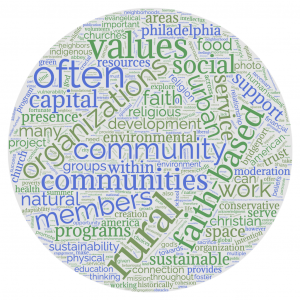
The presence of faith-based organizations as social, human, and cultural capital within every community, regardless of demographic dimension, politics, race, and income demonstrate the resilience of religion as an asset essential to the cultivation of sustainable community development. Throughout history, religious groups have served as providers of essential services for the less fortunate, and advocates for social justice and equity in both rural and urban communities. Despite trying circumstances, this resolute effort over time and their relative success in providing support to those in need, has afforded faith based-organizations credibility, and in some cases their role is indispensable.
My passion for community development began when I had the opportunity to serve the community of Philadelphia, PA by working with The Philadelphia Project, a Christian service organization, in the summers of my teenage years. As a faith-based organization with the mission to partner with local churches, serve their most vulnerable neighbors and provide transformative service opportunities, the project actively strives to offer hope to those they surround. The Philadelphia Project prioritizes the restoration of their community by applying the extended experience of fellowship through service while thinking critically about how God’s word speaks to social issues. A large portion of the organization focuses on their ‘Summer of Service’ program where they host over 100 youth group participants each week, for seven weeks, each summer. This program intends to educate youth on how to serve their community whilst simultaneously working on their relationship with God, instilling an intentional balance of both inward and outward virtues. I participated in my first summer of service in July of 2016, prior to the start of my high school freshman year, and continued to serve for two more summers with The Philadelphia Project in 2017 and 2019. During all three summers, I chose to participate in the home repair service option. By offering volunteer home repair construction teams, The Philadelphia Project seeks to serve the elderly, disabled, single-parent homes, or those struggling with hardship by committing themselves to repair neighborhood homes at no charge to the homeowners. While the physical renovations on these homes were important, my group leaders constantly emphasized the importance of allocating a portion of each day to building relationships with the homeowners. Our task here was to build a home of trust and love, not only repair physical fixtures. The opportunity to foster vulnerable, emotional, conversations with a stranger, whom I could connect with through my faith, and build trust and truthfulness with, was like none other. I found myself opening my heart in ways I had never experienced before, entering a space with the intention to help someone else and leaving with a sense of spiritual fulfillment and emotional growth exposed to me the beautiful effectiveness of faith-based connections. I consider it a privilege to have participated in the work of faith-based organizations, in both rural and urban contexts, throughout my teenage years. Not only have I witnessed the presence of multiple organizations foster resilience, social bonding, and financial provision through faith within their community, but I have witnessed inward growth within myself that I consider truly significant in the development of my genuine passion for the intersection of community development and environmental sustainability.
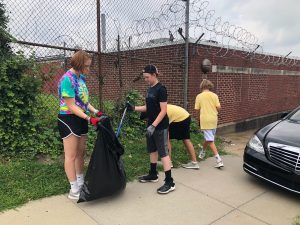
Just as The Philadelphia Project serves their urban area, thousands of faith-based organizations have made it their mission to serve communities across the entirety of America through expressions of their religious beliefs and values. The adaptability of faith-based work contributes to its success and resilience, ranging greatly in size, faith, and expression in response to the demographic diversity of America. In rural American communities, faith-based organizations present themselves most popularly through traditional Christian faiths. As shown in a study by The Harvard School of Public Health, Evangelical, Protestant, and Catholic faiths account for approximately 73% of rural American religious affiliations (Harvard School of Public Health, 2019). Traditional Christian churches have woven themselves into the rural American identity, and many times act as the vital organ of these communities. These physical churches often are accompanied by faith-based thrift stores, some of the most well-known being The Salvation Army and Volunteers of America Thrift Stores, which make affordable clothing accessible for community members in need while raising funds for charities. Similar to thrift stores, food pantries and food kitchens are other sectors of faith-based organizations that are present within rural communities.
Most data surrounding rural religious presence in America points towards the Christian faith, hence the conversation surrounding rural faith-based organizations often excludes and overlooks the presence of rural Indigenous tribal belief communities. Tellingly, “In 2016, Native Americans and Alaskan Natives represented 2% of the U.S. population. However, between 2002 and 2016, the average share of annual grant dollars explicitly benefitting Native Americans was 0.4%” (Native Americans in Philanthropy, 2019). There are many tribal organizations, an example being the Partnership with Native Americans (PWNA), which promote indigenous beliefs and culture while advocating for the rights and education of indigenous community members. Groups like the PWNA, seek to adapt to the needs and goals of the tribal communities that they work with, rather than the other way around. Their vision is to see strong, self-sufficient Native American communities through serving immediate needs and supporting long-term solutions. The indigenous approach to community development ensures that community decision-making processes regard environmental health and appreciate the interconnectedness of life. Indigenous faith-based organizations are exceptional models of how a faith-based development can embed the concept of collective responsibility for the environment within a community-wide pursuit of religious enlightenment.
A traditional community development framework strives to utilize the existing strengths of a community to improve aspects that could enhance the overall functioning of the community. The faith-based organizations that are present within rural communities often exist to provide essential services for the less fortunate and support for social cohesion, therefore encouraging the amplification of values that would otherwise be absent from the community atmosphere. A journal published by scholars at Deakin University mentions that “while religious groups are generally primarily concerned with the spiritual well-being of their members, many have also long been interested in addressing the physical well-being of their communities. Indeed, for many this has often been a core aspect of their existence” (Clarke & Ware, 2015, p. 37). While often flourishing with natural capital and tradition, rural communities possess lower volumes of social and financial capital. It is in these spaces of capital scarcity where the religious values and resources of faith-based organizations have an unparalleled ability to foster growth.
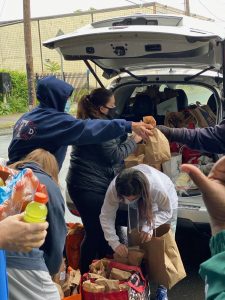
The most prominent service of faith-based organizations is resource provision for the less fortunate. According to the 2019 American Community Survey (ACS), the USDA Economic Research Service reported the rural poverty rate as 15.4 percent, compared with 11.9 percent for urban areas (USDA ERS, 2019). Faith-based organizations are essential providers of food, clothing, finances, and additional support to rural community members who are struggling. Historically, this support has been provided in two forms, ongoing support, and emergency relief. On-going support is often offered to community members in the form of food banks (ex. Food for the Hungry), clothing donations (ex. Clothed by Faith), and smaller direct financial donations. Emergency support often exists as health support (ex. Christian Healthcare Ministries), natural disaster aid (ex. National Disaster Interfaiths Network), and relief programs (ex. Jewish Relief Agency). In all forms, faith-based provisions strive to overcome the generational deprivation of resources and reduce poverty on the front of accessibility. It is important to note that the resources and supplies given out by faith-based organizations are often collected through the generous sharing and donation of other community members. The sacrifice of personal resources for the good of a neighbor profoundly instills values of moderation and unity within the community. The expression of these values in one area of the community often results in an eagerness to act upon them for the betterment of an additional part of the community, a relationship that is significant when assessing the environmental sustainability of a community.
In response to low rural social capital, faith-based organizations offer programs that foster bonding social capital. Programs such as church-based bible study small groups, community gardens, book clubs, and engagement projects, promote social cohesion, companionship, and a sense of neighborhood cohesion. The strengthening of social bonding develops community trust and self-sufficiency, two meaningful indicators of development, and as noted by Martine Vonk (2011), “social capital is the cement of a community” (p. 220). Faith-based programs also provide access to an inclusive identity that expands beyond the small town in which they participate, and provides rural community members the knowledge that they are part of a larger national or global religious community[1]. This expansion of social networking is crucial in supporting the feelings of purpose that are often lost due to the distance and separation of rural communities.
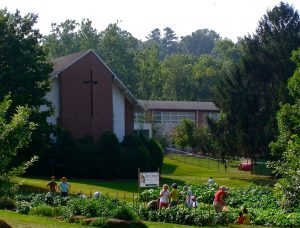
Possessing a great sense of adaptability, faith-based organizations defy the bounds of demographic dimensions, expanding their service outside of rural areas. Faith-based organizations are foundational stakeholders in both rural and urban communities and have committed themselves to bravely entering each space where the diversities of urban community create challenges. Amongst urban centers, a diverse array of churches and religious communities are present and dynamically active. With a presence ranging from large megachurches with campus branches to very small congregations, religious communities have established themselves as gathering places for urban community members who otherwise may feel lost in the vastness of a city. Although urban church presence is often abundant, faith-based organizations with more specified goals also make a home of urban centers. Addiction and recovery programs, family and youth services, food kitchens, shelters, and relief organizations provide resources to neighbors enduring struggles whilst also promoting spiritual health and comfort through relationships. A brilliant exemplar of a successful urban faith-based organization is The Bridgeport Rescue Mission, a provider of food, shelter, clothing, education, job training, and counseling to neighbors in need within the City of Bridgeport, Connecticut, a neighbor of my hometown. This holistic pairing of both spiritual and physical support is representative of the depth of vulnerability, compassion, and identity that secular urban non-profits often lack.
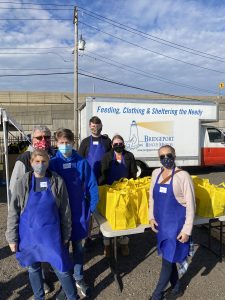
Urban communities possess a great volume of cultural and built capital, however, there is great potential for growth within the areas of human and natural capital which are two areas of development which faith-based organizations have offered their strengths. The density of urban areas often restricts the space necessary for preserved natural areas, such as green space. Many urban community members have resided within a city environment for the entirety of their lives and therefore have had little opportunity to establish a connection with natural environments. The element of limited environmental connection greatly benefits from an integration of religious values of stewardship, purpose, creation, and sacrality. Teaching respect for God’s creation through virtuous ways of living increases the connection that urban community members feel with natural elements, a connection that then often flourishes despite limited exposure to them. In physical terms, outdoor religious retreats are a staple activity for faith-based organizations. Contrasting the lifestyle of those who reside in bustling urban environments with little access to natural capital, religious retreats immerse community members in nature, allowing them to explore a new dimension of their connection with God’s creation. A faith-based outdoor retreat instructional from Adventures Unlimited summarizes the benefits of these retreats, “they allow you to see that it is important for you to appreciate and enjoy the wonderful blessings God has given to all of us. These holy events let you take a step back and appreciate many of the natural things that we often take for granted” (Adventures Unlimited, 2019). I have personally attended five outdoor retreats with Christian faith-based organizations where the beauty of nature as God’s creation was emphasized through exercises such as a star-gazing time of prayer, ropes courses to build trust, and outdoor discussion groups. Another approach was attempted by Christian conservation charity, A Rocha, who has launched a “churchyard conservation”[2] initiative to encourage churches to bring natural areas into their city, increasing their community’s natural capital and accessibility to green space.
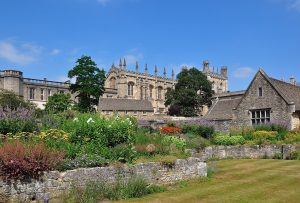
Human capital is often lowered in urban centers due to under-funded education programs and resources. A deficiency of hope within city educational environments often results in feelings of worthlessness, carelessness, confusion, and loss of ambition. The integration of faith-based work into educational settings, for instance, after school programs and interest programs, provides students with a space where they can explore their educational interests with confidence grounded in their faith. This model provides hope for students, teaching them that they are capable of academic success and have been created with intention. By co-developing these programs with the input of inner-city residents, programs can be designed to best create opportunities that are of interest to the community. We can also consider Richard Baer’s (1976) insights into Western society’s imbalance in ratio and intellectus knowledge as support for these initiatives. The school system in America today almost exclusively teaches ratio thinking, logical thought driven by examination, with the destination being a conclusion. Yet, as Baer states, “this perspective regards as irrelevant anything but the measurable, the quantifiable, and the empirically verifiable. Thus it deemphasizes… ethical, religious, and aesthetic dimensions of existence” (p. 474). Faith-based organizations derive their visions and intention from intellectus thinking, the power of contemplation grounded in intuition, creativity, and passivity. The acknowledgment that “the most important and meaningful experiences of our lives are soft, fluid, changing, subtle… much of life can only be understood fully through myth, symbol, analogy, metaphor…” (p. 475) allows urban students to break the bonds of ratio expectation to explore the freedom of creative thinking that under-funded education systems often suppress or cut. The intellectus thinking that faith-based organizations promote, ignites a passion for the exploration of alternative approaches to issues and improvements that could be made within the community.

The focus that faith-based organizations have on cultivating faithfulness, obedience to God, helpfulness for others, and empathy for those in need encourages implicit environmental virtue throughout the community in which they work. The evolution of indirect eco-consciousness accentuates the intersection of faith values and environmental values. It is important to approach this intersection with the knowledge that blunt demands for environmental action within a community do not guarantee responsive sincere communal care for the environment. Community-wide diffusion of faith-based values such as attentiveness, moderation, sacrifice, care, and service often equips community members with a versatile morality that subconsciously constructs ecological intuition. Author Martine Vonk (2011) explores this paradigm in her work ‘Sustainability and Quality of Life’ where she concludes that “behavioural choices with a relatively low impact on the environment are usually not based on a specific or explicit pro-environmental philosophy, but on ideas about quality of life and values” (p. 214). Vonk’s work credits the values of moderation, community, and obedience within religious congregations for their low-impact lifestyles. An example of these faith-based behavioral choices can be seen within the religion of Islam, a religion that highly values moderation. An Islamic teaching states “But when He delivers them to the land, there are some of them who are moderate. And none rejects Our signs except everyone treacherous and ungrateful” (Luqman 31:32), speaking to the disobedience associated with extremism. This behavioral choice, although not explicitly pro-environmental, directs Muslims towards an environmentally low-impact lifestyle, where this value of moderation extends into their patterns of consumption, waste, and diet. These values often stretch across many global religions and are encouraged in the work of a variety of faith-based organizations. Vonk also describes how the communal nature of religion, and faith-based organizations, is “an essential social context for maintaining shared values and preferred behavioural choices” (p. 214) highlighting the importance of accountability that faith-based organization introduces into communities. Virtuous teachings through religion are historically acclaimed for their ability to overcome societal factors of politics, race, and income. Their resiliency and adaptability demonstrate their ability to encourage sustainability through faith-based value across the diversity of American communities.
It would be naive to explore the intersection of religion, community, and the environment without acknowledging the tensions, hesitancies, and misunderstandings that exist obstructing straightforward partnerships between these groups. The obstacles which inhibit community acceptance of environmental values hold historical significance and often are incorporated into the identity of the community. Through an acknowledgment and consideration of the presence of these obstacles, faith-based organizations have the capabilities to overcome, and to heal, broken trusts between communities and environmental virtues. In the rural context, a high percentage of rural communities adopt traditionally conservative beliefs. The issue of environmental sustainability is a historically liberal concern, therefore many rural communities have attached negative connotations to liberal environmental movements, downplaying and hiding environmental values so the community does not sway towards liberal standpoints. Paired with a history of environmentalists unfairly pointing generalized fingers of blame at conservative religions, the language of “sustainability” and “environment” is commonly muted or not received well by these communities. Given this resistance, it is crucial that sustainable development in these communities occurs in a way that is not identified or labeled as ‘environmental’ and that is based on conservative views rather than liberal perspectives. As seen in Martine Vonk’s work, some of this unidentified sustainable development occurs quite naturally through faith-based work in promoting religious values, however, there are additional steps that these organizations must take to facilitate necessary sustainable development within conservative areas. It is crucial that efforts at sustainable development proceed from within the community. Endeavors of “outsider” liberal environmentalists entering rural communities with the intention to “do good” or “fix” the community are often met with animosity. This work must be initiated by members of the conservative community or those who strongly share beliefs with the community. A great example of a sustainability effort initiated by a conservative faith-based group is “Loving the Least of These” an evangelical publication addressing climate change. This study was biblically based and included messages from multiple evangelical pastors, leaders of multiple faith-based organizations, and the president of the National Association of Evangelicals. This publication avoided threatening and accusatory language and focused on solutions by means of Christian engagement guided by biblical advice, and was therefore well accepted by rural evangelical communities.
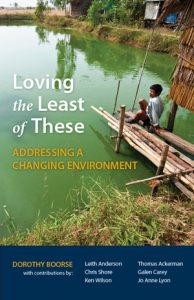
In an urban context, disproportionate impacts of environmental hazards have long impacted low-income and minority urban populations. Historically many companies have exploited urban neighborhoods oppressing them for economic gain. This history has created a lack of trust making it hard for urban residents to decipher if organizations entering their neighborhoods have genuine intentions. It was not until fairly recently that organizations have committed themselves to fight the environmental injustices that plague urban communities. With such a fresh relationship, environmentalist groups often enter neighborhoods with a savior complex looking for short-term gain with no interest in long-term connection. Faith-based organizations must be cautious of this past, and employ compassion to truly listen to community voices that are willing to share the vulnerable traumas of their urban community. They must also be content with a long-term commitment to the community in which they intend to serve. An example of how faith-based organizations can properly enter a low-income urban community is the work of Franklinton Abbey, a new faith community working throughout the westside of Columbus, OH. Franklinton Abbey provides this urban community with a space to “lean into vulnerability”, especially for neighbors in need whose presence is not always accepted elsewhere. Franklinton Abbey is a branch of Vineyard USA, a church network that has dedicated itself to “confront injustice in many ways, working to end human trafficking, pursuing reconciliation, eradicating poverty, and caring for the environment” (Vineyard USA, n.d.). To act beneficially within urban communities, where generational systemic barriers remain present, faith-based organizations must make a conscious commitment to combating injustice.
The investments that faith-based organizations have made towards the improvement of community capitals and the enhancement of quality of life for those in need designates them as necessary figures in the development of sustainable communities across both rural and urban America. By moving beyond the traditional community development framework, faith-based work offers community members access to spaces open to vulnerability, spiritual growth, and relationship. As faith-based groups seek to amplify the values of companionship, trust, and service, communities reap the benefit of increased social, human, natural, and financial capital. The focus that faith-based organizations have on cultivating obedience to God, moderation, and empathy for those in need encourages unspoken environmental virtue throughout the communities in which they work. As I reflect on my experiences with faith-based organizations, which were an extension of the faith community that I was raised in, I see the birth of values such as sacrifice, care, and justice in my own life. Now, as I extend these values into an active ecological consciousness, I recognize that they are foundational to my pursuit of environmentally sustainable community development.
References
Adventures Unlimited. (2019). Planning a church retreat adventure. https://adventuresunlimited.com/adventure-info/church-retreats/
Allard, S. W. (n.d.). Accessibility and stability of nonprofit service providers: Faith-based and community-based organizations in urban and rural America. Compendium of Research Papers presented at the Faith-Based and Community Initiatives Conference on Research, Outcomes, and Evaluation, 79-102. from https://aspe.hhs.gov/sites/default/files/private/pdf/200221/Allard.pdf
Boorse, D. (2011). Loving the least of these. National Association of Evangelicals. http://www.nae.org/wp-content/uploads/2015/06/Loving-the-Least-of-These.pdf
Bridgeport Rescue Mission. (2020). What we do. https://bridgeportrescuemission.org/what-we-do/
Clarke, M., & Ware, V. A. (2015). Understanding faith-based organizations: How FBOs are contrasted with NGOs in international development literature. Sage Journals. https://journals.sagepub.com/doi/pdf/10.1177/1464993414546979
Clugston, R. (n.d.). Faith traditions and sustainable development. Earth Charter. https://earthcharter.org/wp-content/assets/virtual-library2/images/uploads/2%20Manuscrip_Introduccion.pdf
Dar Al-Ifta Al-Missriyyah (2021). Moderation. https://www.dar-alifta.org/Foreign/ViewArticle.aspx?ID=364&CategoryID=3
Harvard School of Public Health (2019). Religious affiliation of rural Americans 2019. Statista. https://www.statista.com/statistics/1009381/religious-affiliation-rural-americans/
Ikerd, J. (2007). The role of the rural church in sustaining rural communities. University of Missouri. http://web.missouri.edu/~ikerdj/papers/Brandon%20–%20IRCA.htm.
Ives, C., & Eymeren, V. A. (2017). Religious faith can help people to build better cities – here’s how. The Conversation. https://theconversation.com/religious-faith-can-help-people-to-build-better-citiesheres-how-88426.
Ives, C. (2017). How can religion help in the pursuit of urban sustainability?. The Nature of Cities. https://www.thenatureofcities.com/2017/10/22/can-religion-help-pursuit-urban-sustainability/
Native Americans in Philanthropy (2019). Investing in native communities. Candid. https://www.issuelab.org/resources/35493/35493.pdf?download=true&_ga=2.56827946.1209014558.1604941390-1531925363.1604941390
Partnership With Native Americans. (2021). Long-term solutions community investment. http://www.nativepartnership.org/site/PageServer?pagename=pwna_longterm_community
The Philadelphia Project. (n.d.). Mission and vision. https://www.huduser.gov/portal/publications/faithbased.pdf.
USDA ERS. (2019). Rural poverty & well-being. https://www.ers.usda.gov/topics/rural-economy-population/rural-poverty-well-being/#historic
Vidal, A. C. (2001). Faith-based organizations in community development. Hud User PD&R. https://www.huduser.gov/portal/publications/faithbased.pdf.
Vineyard USA. (n.d.) Justice & our neighborhoods. https://vineyardusa.org/explore/justice-our-neighborhoods/
Vonk, M. (2011). Sustainability and quality of life. Vrije Universiteit. https://citeseerx.ist.psu.edu/viewdoc/download?doi=10.1.1.891.578&rep=rep1&type=pdf
- Notably, the United Nations Environment Programme has recently developed a global program, the Faith for Nature program, which is designed to link local faith communities with sustainable development organizations that can provide resources for community resilience and experience in implementing successful sustainable development projects. https://www.unep.org/faith-earth-dialogue-unea-52 ↵
- Wilder Churches, a partnership between Somerset Wildlife Trust and the Diocese of Bath and Wells supports communities by educating them on the wildlife in their local churchyards, other church land or burial grounds and provides management strategies to increase the value of these special places for wildlife and green space. https://www.bathandwells.org.uk/faith/environment/encouraging-biodiversity https://www.somersetwildlife.org/events/wilder-churches/ ↵
